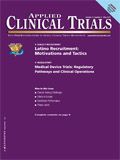FDA's Safety Data Collection Draft Guidance
Applied Clinical Trials
FDA Draft Guidance "Determining the Extent of Safety Data Collection Needed in Late Stage Premarket and postapproval Clinical Investigations" is reviewed.
Staying busy is never a problem in the clinical trials industry. Often finding a few minutes in the day to take a breath can seem like a futile search. Keeping up on the newest FDA publications can be a daunting and time consuming task. With that in mind, Cynthia Verst, Senior Vice President, Global Head of Business Operations at Quintiles Outcome agreed to review the latest draft guidance and answer a few questions to help keep Applied Clinical Trials' readers up to date.

Cynthia Verst is the Senior Vice President, Global Head of Business Operations at Quintiles Outcome.
What are the key points of the draft guidance titled, "Determining the Extent of Safety Data Collection Needed in Late Stage Premarket and Postapproval Clinical Investigations?"
This draft guidance is intended to assist sponsors of clinical trials of investigational drug and biological products in determining the amount and types of safety data to collect during late stage premarket and postmarket clinical investigations. The draft guidance is consistent with the FDA's overall approach to safety assessment which emphasizes "quality over quantity."
Targeted safety data collection is appropriate when the following conditions are met: the number of subjects exposed to the drug in previous studies is sufficient to characterize the safety profile for all but rare events; the occurrence of adverse events has been generally similar across many studies; there is a reasonable basis to conclude that the occurrence of adverse events in the population to be studied will be similar to previously observed rates.
The criteria are most likely to be applicable in postmarket studies including studies of new indications, postmarketing requirements and large outcome trials. In some circumstances, the criteria may also be met in late Phase III studies, where the safety database is already well characterized.
What effect do you feel this guidance will have on the clinical trial industry?
This draft guidance will give the clinical trials industry greater confidence to design more targeted and efficient trials. More streamlined data collection will: improve the quality and utility of the safety database whilst retaining trial validity and utility; help investigator and patient participation in trials, which is an issue across the industry; and act as an enabler for larger, simpler outcome and long-term trials which can be logistically difficult, take time, and carry high costs.
The clinical trials industry, FDA, physicians, and patients all stand to benefit from this draft guidance.
When designing a plan for data collection for a late stage premarket and postapproval clinical investigation, how should a sponsor draw the distinction between necessary and unnecessary data?
It is important to recognize that there remain circumstances when comprehensive safety data collection would be expected. These include development programs for original market applications. In addition, it is typically not appropriate when there are important differences in the patient population, dose, dosage regimen, duration of use, or route of administration compared to the existing label. Development programs for orphan indications would also be excluded due to the limited patient population available to study. Full safety data collection is also needed when assessing specific adverse events and baseline risk factors.
Data that should always be collected includes data in special populations (e.g., pediatric patients), certain adverse event data (e.g., serious adverse events), study subject withdrawals, adverse events designated as important for reporting, and long-term exposure to chronic usage treatments.
Safety data that may be appropriate for abbreviated collection or non-collection includes: non-serious adverse events not associated with drug discontinuation; routine lab monitoring; information on concomitant medications; and history and physical examination.
A targeted safety data collection plan should be clearly described in the study protocol including: pre-identification of data that need not be collected; collection of data in a subset of the study population; and less frequent collection of data.
Sponsors are recommended to consult with the relevant FDA division on the feasibility and acceptability of the safety plan prior to implementation.
—Timothy Denman

Behind the Buzz: Why Clinical Research Leaders Flock to SCOPE Summit
February 7th 2025In this episode, we meet with Micah Lieberman, Executive Conference Director for SCOPE Summit (Summit for Clinical Ops Executives) at Cambridge Innovation Institute. We will dive deep into the critical role of collaboration within the clinical research ecosystem. How do we bring together diverse stakeholders—sponsors, CROs, clinical trial tech innovators, suppliers, patients, sites, advocacy organizations, investors, and non-profits—to share best practices in trial design, program planning, innovation, and clinical operations? We’ll explore why it’s vital for thought leaders to step beyond their own organizations and learn from others, exchanging ideas that drive advancements in clinical research. Additionally, we’ll discuss the pivotal role of scientific conferences like SCOPE Summit in fostering these essential connections and collaborations, helping shape the future of clinical trials. Join us as we uncover how collective wisdom and cross-industry partnerships are transforming the landscape of clinical research.
Reaching Diverse Patient Populations With Personalized Treatment Methods
January 20th 2025Daejin Abidoye, head of solid tumors, oncology development, AbbVie, discusses a number of topics around diversity in clinical research including industry’s greatest challenges in reaching diverse patient populations, personalized treatment methods, recruitment strategies, and more.